词汇学基础第六章 词义的发展
- 格式:ppt
- 大小:579.00 KB
- 文档页数:49


论述题一、一般词汇与基本词汇的关系基本词汇和一般词汇都有各自特点,因此,它们是语言词汇中两个完全不同的部分。
但是,基本词汇和一般词汇又有非常密切的联系,它们相互依存,共同发展,都是语言词汇中不可缺少的部分。
第一,基本词汇是语言的基础,它也是一般词汇形成的基础,一般词汇中的大多数词都是在基本词汇基础上形成的。
第二,一般词汇反映社会的发展是非常敏感的,它几乎经常存在不吨的变动之中,因此,语言词汇中的新成分往往首先出现在一般词汇中,然后个别成分再进入基本词汇中,促成基本词汇的发展。
从这一角度讲,一般词汇又可以充当基本词汇发展的源泉。
第三,基本词汇和一般词汇中的个别成分又是可以互相转换,在词汇发展的过程中,随着社会交际需要的改变,某些基本词转化成一般词,而某些一般词也能转化为基本词汇,如过去的基本词“鬼、窝窝头”等,现在已成了一般词,又如过去的一般词“党”,现在已经由一般词转化成基本词,成为“共产党”的简称。
总之,基本词汇和一般词汇就是在这样相互依存不断转化的关系中间共同发展和丰富起来。
它们的发展又形成整个词汇的形成。
二、词义发展的概况1、新词的增加。
语言是随着社会的发展而发展的,在这发展过程当中,词汇又是最敏感的部分,因此,社会上的一切都会在词汇中有所反映,这就促成了语言中新词的不断增加。
2、双音词的增多。
随着汉语的发展,词汇中的双音词逐渐增多起来,由单音向双音发展,是汉语词汇发展的一种必然现象。
因为随着社会的发展,交际的需求越来越纷繁复杂,需要表示的事物越来越多,有限的单音节形式就必然造成语言中同音词的大量出现。
因而给人们的交际带来许多不便,汉语词的双音化就此发展起来。
3、实词虚化现象的发展。
主要表现在两个方面:一方面是由实词类变为虚词类,如“因”原为“原因”,而后发展为“因为”,充当连词使用;另一方面,是由可以充当词根词素的实词虚化成了附加词素,如“了”原为“了结”虚化成了“好了”。
“了结”是实词,后来虚化成了词尾词素,读为“le”附在动词后面,表示完成体的语法意义,如“看了”、“做了”。
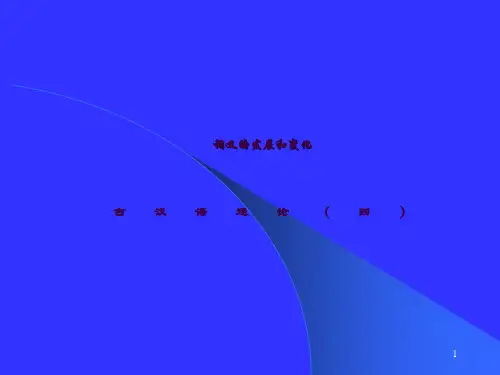
![语言学概论[第六章词义]山东大学期末考试知识点复习](https://uimg.taocdn.com/7cfc17851711cc7930b716e3.webp)
第六章词义1.词汇与词汇分类词汇又叫语汇,是构成语言的基本材料.它既可以指一种具体语言或方言中的全部的词和固定词组,也可以指语言中某类词语的总和,还可以指某个作品中所使用的词的总和.但是它不能指一个个具体的词或固定词组.根据词汇的稳定程度,它可以分为基本词汇与一般词汇两种.基本词汇在语言发展中是相对稳定的,一般词汇则敏感地反映着社会的发展和人们生活的变化,于不断产生、消亡等变化之中.基本词汇与一般词汇相对,是词汇系统的基础和核心。
标志着与人们世世代代的日常生活有密切关系的事物的词以及表示事物关系的常用虚词的总汇叫基本词汇,它是词汇中的主要部分,具有全民常用性、稳固性、能产性等特点。
一般词汇是指词汇中基本词汇以外的词。
它紧随社会的发展与人们生活的变化而变化,稳固性差,构词能力弱,有时候它可以转换为基本词汇。
它包括古语词、方言词、外来词、新造词等。
另外,从词的用途与特点来看,词汇可以分为通用词汇与专用词汇、常用词汇与罕用词汇.2.词义词义是指人们对现实现象的反映以及由此带来的人们对现实现象的主观评价,它包括词的理性意义与附加色彩。
它具有概括性、模糊性、民族性、主观性特点。
3.词的理性意义与非理性意义词的理性意义是指以现实现象为基础,不涉及人们主观态度的词义.它是词义的基础与核心部分。
根据人们对事物本质特征的反映情况,词的理性意义可以分为通俗意义与科学意义两种。
词的非理性意义,又叫词的附加色彩,是人们对客观世界认识的价值观念、立场态度和语言使用上的主观看法.它附着在词的理性意义之上,可以分为三类:一是感情色彩,它有褒义、贬义与中性之分;二是语体色彩,词的语体色彩分为口语色彩和书面语色彩两种基本类型;三是形象色彩,是因为描绘人或事物的形象、情状或特征而使词带上了形象性、可感性和比喻性等特点,可以引起人们对事物视觉形象或听觉形象的联想.4.词的本义、基本义、引申义、派生义本义是指词的有历史可查的最初的意义。
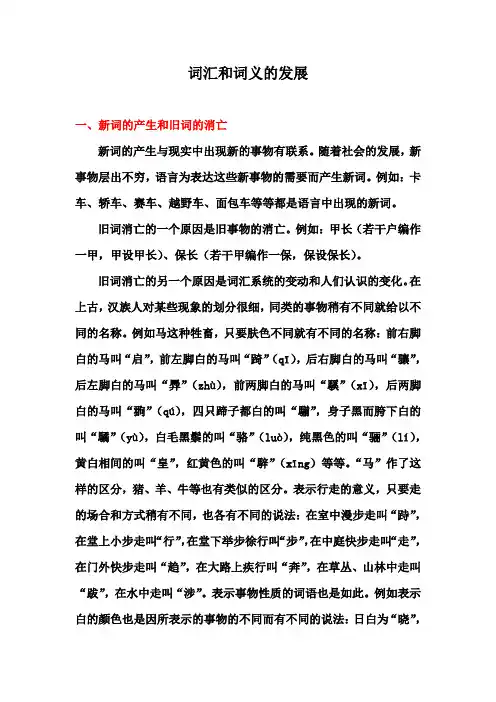
词汇和词义的发展一、新词的产生和旧词的消亡新词的产生与现实中出现新的事物有联系。
随着社会的发展,新事物层出不穷,语言为表达这些新事物的需要而产生新词。
例如:卡车、轿车、赛车、越野车、面包车等等都是语言中出现的新词。
旧词消亡的一个原因是旧事物的消亡。
例如:甲长(若干户编作一甲,甲设甲长)、保长(若干甲编作一保,保设保长)。
旧词消亡的另一个原因是词汇系统的变动和人们认识的变化。
在上古,汉族人对某些现象的划分很细,同类的事物稍有不同就给以不同的名称。
例如马这种牲畜,只要肤色不同就有不同的名称:前右脚白的马叫“启”,前左脚白的马叫“踦”(qī),后右脚白的马叫“骧”,后左脚白的马叫“馵”(zhù),前两脚白的马叫“騱”(xī),后两脚白的马叫“翑”(qú),四只蹄子都白的叫“騚”,身子黑而胯下白的叫“驈”(yù),白毛黑鬃的叫“骆”(luò),纯黑色的叫“骊”(lí),黄白相间的叫“皇”,红黄色的叫“騂”(xīng)等等。
“马”作了这样的区分,猪、羊、牛等也有类似的区分。
表示行走的意义,只要走的场合和方式稍有不同,也各有不同的说法:在室中漫步走叫“跱”,在堂上小步走叫“行”,在堂下举步徐行叫“步”,在中庭快步走叫“走”,在门外快步走叫“趋”,在大路上疾行叫“奔”,在草丛、山林中走叫“跋”,在水中走叫“涉”。
表示事物性质的词语也是如此。
例如表示白的颜色也是因所表示的事物的不同而有不同的说法:日白为“晓”,月白为“皎”,霜雪白为“皑”(ái),草花白为“皅(pā)”,玉石白为“皦”(jiǎo),人白为“皙”,鸟白为“”(hé)。
随着社会的发展,新事物、新现象越来越多,如果继续给每一类新事物、新现象起一个单音节的名称,这必然增加人们记忆的负担,不便于语言的学习和使用。
后来,人们把事物的小类归成大类:不同颜色的马都归为马,不同场合和方式的走都是走,不同事物的白都是白。
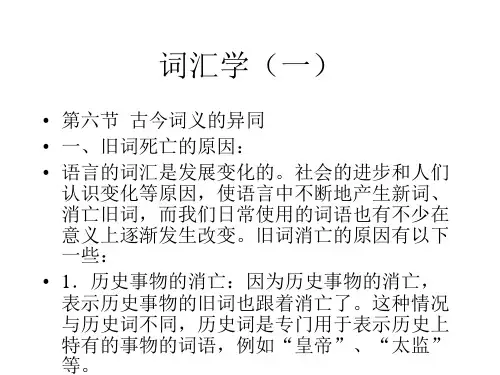
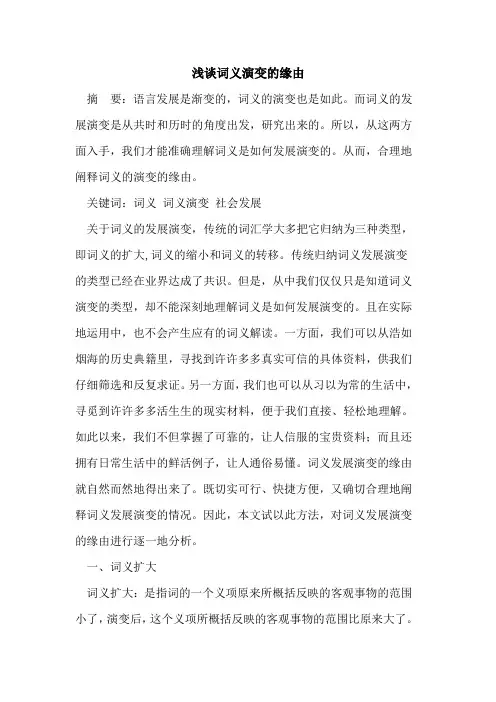
浅谈词义演变的缘由摘要:语言发展是渐变的,词义的演变也是如此。
而词义的发展演变是从共时和历时的角度出发,研究出来的。
所以,从这两方面入手,我们才能准确理解词义是如何发展演变的。
从而,合理地阐释词义的演变的缘由。
关键词:词义词义演变社会发展关于词义的发展演变,传统的词汇学大多把它归纳为三种类型,即词义的扩大,词义的缩小和词义的转移。
传统归纳词义发展演变的类型已经在业界达成了共识。
但是,从中我们仅仅只是知道词义演变的类型,却不能深刻地理解词义是如何发展演变的。
且在实际地运用中,也不会产生应有的词义解读。
一方面,我们可以从浩如烟海的历史典籍里,寻找到许许多多真实可信的具体资料,供我们仔细筛选和反复求证。
另一方面,我们也可以从习以为常的生活中,寻觅到许许多多活生生的现实材料,便于我们直接、轻松地理解。
如此以来,我们不但掌握了可靠的,让人信服的宝贵资料;而且还拥有日常生活中的鲜活例子,让人通俗易懂。
词义发展演变的缘由就自然而然地得出来了。
既切实可行、快捷方便,又确切合理地阐释词义发展演变的情况。
因此,本文试以此方法,对词义发展演变的缘由进行逐一地分析。
一、词义扩大词义扩大:是指词的一个义项原来所概括反映的客观事物的范围小了,演变后,这个义项所概括反映的客观事物的范围比原来大了。
虽然词义的扩大的意思看似很简单,但是它却蕴含了很多丰富的知识。
首先,从词义本身来说。
众所周知,考古发现的资料已证明了汉字产生的主要途径是图画。
同时,我们也知道汉字属于表意体系的文字。
显然,这两者是相互依存的。
因为要很好的表意,图画实在是再好不过的载体了(这里只说造字之初,且图画有读音和意义),后来随着社会的发展逐渐淡化,甚至,被象征符号所代替。
随着人类一代代的繁衍,生产生活水平的提高,日常生活交流的频繁。
语言也会越来越需要完美表达。
于是,就利用当时现有的字来满足表达的需要。
例如,上古的“说”字,除了说话,游说意义之外,还表示喜悦,高兴等意义。

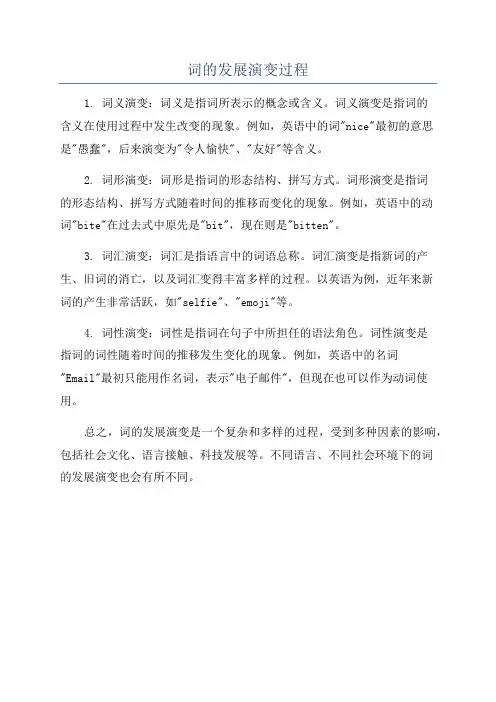
词的发展演变过程
1. 词义演变:词义是指词所表示的概念或含义。
词义演变是指词的
含义在使用过程中发生改变的现象。
例如,英语中的词"nice"最初的意思是"愚蠢",后来演变为"令人愉快"、"友好"等含义。
2. 词形演变:词形是指词的形态结构、拼写方式。
词形演变是指词
的形态结构、拼写方式随着时间的推移而变化的现象。
例如,英语中的动词"bite"在过去式中原先是"bit",现在则是"bitten"。
3. 词汇演变:词汇是指语言中的词语总称。
词汇演变是指新词的产生、旧词的消亡,以及词汇变得丰富多样的过程。
以英语为例,近年来新
词的产生非常活跃,如"selfie"、"emoji"等。
4. 词性演变:词性是指词在句子中所担任的语法角色。
词性演变是
指词的词性随着时间的推移发生变化的现象。
例如,英语中的名词"Email"最初只能用作名词,表示"电子邮件",但现在也可以作为动词使用。
总之,词的发展演变是一个复杂和多样的过程,受到多种因素的影响,包括社会文化、语言接触、科技发展等。
不同语言、不同社会环境下的词
的发展演变也会有所不同。
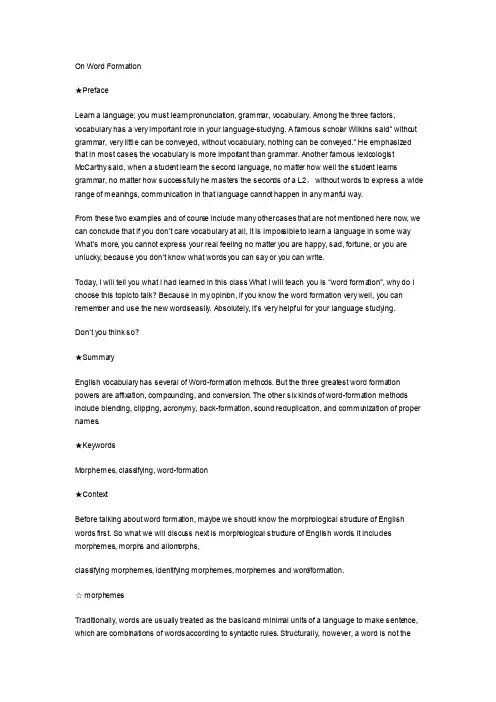
On Word Format ion★Prefac eLearna langua ge; you must learnpronun ciati on, gramma r, vocabu lary. Amongthe threefactor s,vocabu laryhas a very import ant role in your langua ge-studyi ng. A famous schola r Wilkin ssaid”withou t gramma r, very little can be convey ed, withou t vocabu lary, nothin g can be convey ed.”Heemphas izedthat in most cases, the vocabu laryis more import ant than gramma r. Anothe r famous lexico logis tMcCart hy said, when a studen t learnthe second langua ge, no matter how well the studen t learns gramma r, no matter how succes sfull y he master s the second s of a L2, withou t wordsto expres s a wide rangeof meanin gs, commun icati on in that langua ge cannot happen in any manful way.From thesetwo exampl es and of course includ e many othercasesthat are not mentio ned here now, we can conclu dethatifyoudon‟tcarevocabu laryat all, it is imposs ibleto learna langua ge in some way. What‟smore, you cannot expres s your real feelin g no matter you are happy, sad, fortun e, or you are unluck y, becaus eyoudon‟tknowwhatwordsyou can say or you can write.Today, I will tell you what I had learne d in this class. What I will teachyouis“wordformat ion”,whydoIchoose this topicto talk? Becaus e in my opinio n, if you know the word format ion very well, you can rememb er and use the new wordseasily. Absolu tely,it‟sveryhelpfu l for your langua ge studyi ng.Don‟tyouthinkso?★Summar yEnglis h vocabu laryhas severa l of Word-format ion method s. But the threegreate st word format ion powers are affixa tion, compou nding, and conver sion. The othersix kindsof word-format ion method s includ e blendi ng, clippi ng, acrony my, back-format ion, soundredupl icati on, and commun izati on of proper names.★Keywor dsMorphe mes, classi fying, word-format ion★Contex tBefore talkin g aboutword format ion, maybewe should know the morpho logic al struct ure of Englis h wordsfirst. So what we will discus s next is morpho logic al struct ure of Englis h words. It includ esmorphe mes, morphs and allomo rphs,classi fying morphe mes, identi fying morphe mes, morphe mes and word-format ion.☆ morphe mesTradit ional ly, wordsare usuall y treate d as the basicand minima l unitsof a langua ge to make senten ce, whichare combin ation s of wordsaccord ing to syntac tic rules. Struct urall y, howeve r, a word is not thesmalle st unit becaus e many wordscan be separa ted into even smalle r meanin gfulunits. Theseminima l meanin gfulunitsare knownas morphe mes. In view of word-format ion, the morphe meisseenas…thesmalle st functi oning unit in the compos ition of words‟. Syntac tical ly, howeve r, a morphe me is the minima l form of gramma tical analys is.Morphe mes are abstra ct units, whichare realiz ed in speech by discre te unitsknownas morphs. They are actual spoken, minima l carrie rs of meanin g.Morphe mes vary in functi on. Accord ingly, we can classi fy morphe mes into severa l genera l catego ries:① Free versus BoundMorphe mes ---- morphe mes whichare indepe ndent of othermorphe mes are free. Thesemorphe mes have comple te meanin gs in themse lvesand can be used as free gramma tical unitsin senten ces. Morphe mes whichcannot occuras separa te wordsare bound. They are so namedbecaus e they are boundto othermorphe mes to form wordsor to perfor m a partic ulargramma tical functi on.② Deriva tiona l versus Inflec tiona l Morphe mes ---- morphe mes whichare used to derive new wordsare knownas deriva tiona l morphe mes becaus e when thesemorphe mes are conjoi ned, new wordsare derive d.③ Conten t versus Gramma tical Morphe mes ---- On a semant ic and syntac tic basis, morphe mes can fall into conten t and gramma tical morphe mes. Conten t morphe mes are lexica l morphe mes whichare used as we see aboveto derive new words, so also knownas deriva tiona l morphe mes.☆ Morphe mes and Word-format ionWe know that wordscan be analyz ed into morphe mes, whichare the minima l meanin gfulunitsin the compos ition of words. In word-format ion format ion, howeve r, morphe mes are conven tiona lly labele d root, stem, base and affix.Affixe s are formsthat are attach ed to wordsor elemen ts to modify meanin g or functi on. Affixe s are boundmorphe mes becaus e none of them can standas wordsin theirown right. Accord ing to the functi ons of affixe s, we can divide them into inflec tiona l affixe s and deriva tiona l affixe s. Deriva tiona l and inflec tiona l affixe s are identi cal with deriva tiona l and inflec tiona l morphe mes. In view of theirdistri butio n in the format ion of word, affixe s can fall into prefix and suffix.Before we beginour actual discus sionof word-buildi ng proces ses, thereare some basicconcep ts that need clarif ying:1. Root: a root is the basicform of a word whichcannot be furthe r analyz ed withou t totalloss of identi ty.2. Stem: a stem may consis t of a single root morphe me or of two root morphe mes. It can be a root morphe me plus one or more affixa tiona l morphe mes.3. Base: a base is referr ed to a form to whichaffixe s of any kind can be added. It can be a root or a stem.☆ Word Format ionThe expans ion of vocabu laryin modern Englis h depend s chiefl y on word format ion. Thereis a variet y of meansbeingat work now. The most produc tiveare affixa tion, compou nding and conver sion.⑴ Affixa tionAffixa tionis genera lly define d as the format ion of wordsby adding word-formin gor deriva tiona l affixe s to base. This proces s is also knownas deriva tion, by whichnew wordsare derive d from old or base forms. The wordscreate d in this way are called deriva tives. Accord ing to the positi ons affixe s occupy in words, affixa tionfallsinto two subcat egori es: prefix ation and suffix ation.Prefix ation includ es:Negati ve Prefix es (a-, dis- ,in-, non-, un-…)Revers ative or Privat ive Prefix es (de-, dis-,un,…)Pejora tivePrefix es (mal-, mis-, pseudo- …)Prefix es of Degree or Size (arch-, co-, extra-, hyper-, macro-, micro-, mini-, out-,over-, sub-, super-, sur-, ultra-, under-…)Prefix es of Orient ation and Attitu de (anti-, contra-, counte r-, pro-…)Locati ve Prefix es ( fore-, inter-, intra-, super-, tele-, trans-…)Prefix es of Time and Order( ex-, fore-, post-, pre-, re- …)Number Prefix es ( bi-, multi-, semi-,tri-,uni- …)Conver sionPrefix es ( a-, be-, en- …)Miscel laneo us Prefix es ( auto- , neo-, pan-, proto-, vice- …)Suffix ation includ es:Noun suffix es (denomi nal nouns, deverb al nouns, de-adject ive nouns, non andadject ive suffix es) Adject ive suffix es (denomi nal suffix es, deverb al suffix es )Adverb suffix es (Omit exampl e)Verb suffix es (Omit exampl e)⑵ Compou ndingCompou nding is the format ion of new wordsby joinin g two or more bases. Wordsw orthformed in this way are called compou nds. Compou nds can be writte n solid, hyphen atedand open.1. Charac teris ticsof compou ndsCompou nds have notice ablecharac teris ticswhichmay in most casesdiffer entia te themse lvesfrom noun phrase s in the follow ing four aspect s:Phonol ogica l featur es, semant ic featur es, gramma tical, orthog raphi cal featur es.2. Format ion of compou ndsCompou nding can take placewithin any of the word class, but the produc tiveones are nounsand adject ivesfollow ed by verbsto a much lesser extent. Noun compou nds, adject ive compou nds, verb compou nds.⑶ Conver sionConver sionis the format ion of new wordsby conver tingwordsof one classto anothe r class. Conver sionis genera lly consid eredto be a deriva tiona l proces swhereb y an item is adapte d or conver ted to a new word classwithou t the additi on of an affix. Hencethe name zero-deriva tion. Wordsproduc ed by conver sionare primar ily nouns, adject ives, and verbs.Conver sionto nouns(deverb al, de-adject ival, miscel laneo us conver sion) Conver sionto verbs(denomi nal, de-adject ival, miscel laneo us conver sion) conver sionto adject ives(voicel ess to voiced conson ant, initia l to end stress) the othersix meansof word-format ion includ es:Blendi ng, Clippi ng, Acrony my, Back-format ion, Soundredupl icati on, Commun izati on of proper names.Becaus e the wordslimit, the six word-format ion method s is not detail ed introd ucedhere. If you areintere stedin them, please referto the lexico logy.Annota tion:《英语词汇学教程》张伟友著,《词汇学学习指南》Thankyou for your review s !A happyNew Year, good health杨春慧著。
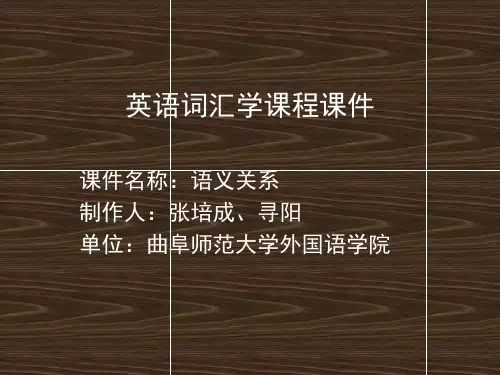
理论教学教案(总第 13- 14学时)项目名称第六章词的语义分类授课学时2任务名称理解词的语义分类教学目标1. 词与词的上下义关系2. 词与词的同义关系3.词与词的反义关系4. 词与词的同形或同音异义关系教学重点词与词的上下义关系教学难点词与词的同义反义关系教学资源PPT教学过程设计教学内容时间分配教学活动设计Step1: 引入复习上一次学习内容Step2: 新课讲授-词的语义分类l.词与词之间的上下义关系概念:语义场 Semantic field类概念(genus)种概念(species)探讨词所表达的类概念与词所表达的种概念之间的关系。
词可以在一个共同的概念下的支配下结合在一起形成语义场。
上下义关系或语义内包指表示个别类概念的词内包在表示一般概念的词中。
关系:互为依存2.词与词之间的同义关系概念:词与词可以因表达同一的逻辑概念而结合在一起,这些词称之为同义词。
特点:1. 同义词意义相同,但形位结构,音位形状和用法不同。
2. 一对一组同义词并不是一成不变的,一个词可以和一部分词构成同义词,也可与另外一部分词构成同义词。
如:look: see; watch; observe seem; appear.同义词之间的差异1. 语义上的差异eg: A teacher was amazed to find that a lazy student had gained a mark of 100 in an important testamaze:难以相信astound:难以相信的程度更高。
escape: flee: 紧急情况下的仓促逃跑2. 感情色彩和语体色彩上的差异感情色彩上:高雅(elevated)、中性(neutral)、粗俗(Vulgar)单词————感情色彩——使用场合horse———中性——----一切场合charger/steed——---高雅——-----诗歌小说plug/nag-----粗俗—-----—口语3. 词与词之间的反义关系词与词之间存在着相反或对立的语义关系——反义关系(antonymy).词义相反或对立的词叫做反义词(antonyms)1. 以词根和派生为依据所形成的的反义关系Clear——vague Large—— smallUp——down (词根反义词)Pleasant ——unpleasantPolite —— impoliteHonest —— dishonest(派生反义词)作业布置复习所学内容授课日期及授课地点明德楼205 第8周下午67节课后反思词与词的上下义关系稍难理解,建议增加案例讲解。
词汇学英语单词的语义发展The semantic development of English words is a fascinating aspect of lexicology that involves the study of how the meanings of words change over time. This process is often influenced by a variety of factors, includingcultural shifts, technological advancements, and linguistic contact with other languages. In this article, we will explore the semantic development of English words, focusing on how their meanings evolve and the factors thatcontribute to these changes.I. Introduction.The study of word meanings and their historical development is crucial in understanding the evolution of language. As languages evolve, so do the meanings of their constituent words. This semantic change can be gradual or abrupt, and it can occur for various reasons. Understanding these changes not only sheds light on the history of a language but also provides insights into how people thinkand communicate.II. Types of Semantic Change.A. Broadening (Generalization)。